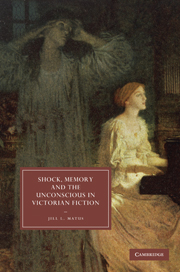Book contents
- Frontmatter
- Contents
- Acknowledgements
- Introduction: the psyche in pain
- 1 Historicizing trauma
- 2 Dream and trance: Gaskell's North and South as a “condition-of-consciousness” novel
- 3 Memory and aftermath: from Dickens's “The Signalman” to The Mystery of Edwin Drood
- 4 Overwhelming emotion and psychic shock in George Eliot's The Lifted Veil and Daniel Deronda
- 5 Dissociation and multiple selves: memory, Myers and Stevenson's “shilling shocker”
- Afterword on afterwards
- Notes
- Selected bibliography
- Index
- CAMBRIDGE STUDIES IN NINETEENTH-CENTURY LITERATURE AND CULTURE
3 - Memory and aftermath: from Dickens's “The Signalman” to The Mystery of Edwin Drood
Published online by Cambridge University Press: 30 January 2010
- Frontmatter
- Contents
- Acknowledgements
- Introduction: the psyche in pain
- 1 Historicizing trauma
- 2 Dream and trance: Gaskell's North and South as a “condition-of-consciousness” novel
- 3 Memory and aftermath: from Dickens's “The Signalman” to The Mystery of Edwin Drood
- 4 Overwhelming emotion and psychic shock in George Eliot's The Lifted Veil and Daniel Deronda
- 5 Dissociation and multiple selves: memory, Myers and Stevenson's “shilling shocker”
- Afterword on afterwards
- Notes
- Selected bibliography
- Index
- CAMBRIDGE STUDIES IN NINETEENTH-CENTURY LITERATURE AND CULTURE
Summary
TRAUMA, MEMORY AND RA ILWAY DISASTER: “THE SIGNALMAN”
In 1865 Charles Dickens narrowly escaped death when the train on which he was traveling from Folkestone to London jumped a gap in the line occasioned by some repair work on a viaduct near Staplehurst, Kent. The foreman on the job miscalculated the time of the train's arrival; the flagman was only 550 yards from the works and unable to give adequate warning of the train's approach. The central and rear carriages fell off the bridge, plunging onto the river-bed below. Only one of the first-class carriages escaped that plunge, coupled fast to the second-class carriage in front: “It had come off the rail and was … hanging over the bridge at an angle, so that all three of them were tilted down into a corner.” Dickens managed to get Ellen Ternan and her mother, with whom he was traveling, out of the carriage and then behaved with remarkable self-possession, climbing down into the ravine and ministering to the many who lay injured and dying. With further aplomb, he climbed back into the dangerously unstable carriage and retrieved his manuscript, a fear which is recounted in the memorable postscript to Our Mutual Friend (1865).
Once back in London, however, Dickens began to develop the symptoms that today we would recognize as typical of trauma. He was greatly shaken and lost his voice for nearly two weeks: “I most unaccountably brought someone else's out of that terrible scene,” he said.
- Type
- Chapter
- Information
- Shock, Memory and the Unconscious in Victorian Fiction , pp. 83 - 120Publisher: Cambridge University PressPrint publication year: 2009



